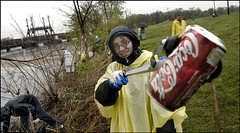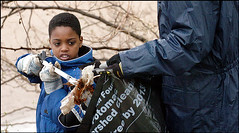Spring cleanup... fall cleanup ... promoting cleaning behavior by building mental maps through experience
 A drizzle-drenched Annie Early displays a soda can she retrieved along the shoreline at the District's Anacostia Waterfront Park. (Photos By Gerald Martineau -- The Washington Post) From "Putting the Region's Waterways in Order: Volunteers Spend 'Humbling' Saturday Picking Up the Trash of the Careless."
A drizzle-drenched Annie Early displays a soda can she retrieved along the shoreline at the District's Anacostia Waterfront Park. (Photos By Gerald Martineau -- The Washington Post) From "Putting the Region's Waterways in Order: Volunteers Spend 'Humbling' Saturday Picking Up the Trash of the Careless."A previous engagement kept me from participating in last weekend's Potomac River Cleanup, about which the Post editorialized today, in "Spring Cleanup: Volunteers step up. Local governments and companies should join in." From the editorial:
The cleanup was organized by the Alice Ferguson Foundation, an environmental group whose own headquarters in Accokeek, on the Maryland side of the Potomac River across from Mount Vernon, fights a war against garbage floating downriver. This was the 18th annual cleanup, reflecting the energy and determination of its organizers: 4,000 volunteers at 150 sites across Maryland, Virginia and the District, working through Saturday morning despite heavy rain, and collecting 150 to 200 tons of trash.
It goes on to editorialize about how to do more to create "a 'trash-free Potomac."
The biggest problem is that people lack a sense of connectedness to the environment, an ethic about trash, litter, and responsibility. The best way to address this is to build its development into our learning system, not just within schools but more broadly.
Yesterday, I set aside an article because it mentioned how a particular Main Street program has its annual cleanup on Earth Day (April 22nd) which I think makes sense from a tie-in standpoint (it has to do with leveraging organizational support, marketing, and a hook...). That's something to think about. (The article is "Main Street celebrates Earth Day with cleanup.")
Another is the role of the rivers (Potomac and Anacostia) in the city and the city's history, as well as a great venue to teach about the environment.
But I am getting ahead of myself. For many many years I have been intrigued by an article I read more than ten years ago in the New York Times Sunday Magazine about elementary education in Japan. In Japan, the schools don't have custodians; the children are responsible for cleaning the school. Now, it might not get quite as clean as it should, but the kids learn about what happens when they make messes...
Similarly, in efforts on litter interdiction in the H Street NE neighborhood, I made the following suggestion (although I am no longer involved with H Street Main Street, so I didn't execute it):
I think that every elementary school should have a fall and a spring cleanup activity around a minimum of a one block radius around the school. This should be done in conjunction with local organizations. But every school in the city should do it, every fall, and every spring, every year... Children become adults. And they would learn how to properly dispose of trash (and ideally, eventually, that it's a good idea to create less trash). Some of the trash littering our streets and sidewalks ends up in the Anacostia and Potomac Rivers...
For more of my thinking about this, see the blog entry "Every Litter Bit Hurts" from last April.
 Aaron Lewis III, 8, puts some trash into a bag held by his father, Aaron Lewis Jr., at Anacostia Waterfront Park. Post photo by Gerald Martineau.
Aaron Lewis III, 8, puts some trash into a bag held by his father, Aaron Lewis Jr., at Anacostia Waterfront Park. Post photo by Gerald Martineau.Index Keywords: civic-engagement; quality-of-life-advocacy



0 Comments:
Post a Comment
<< Home